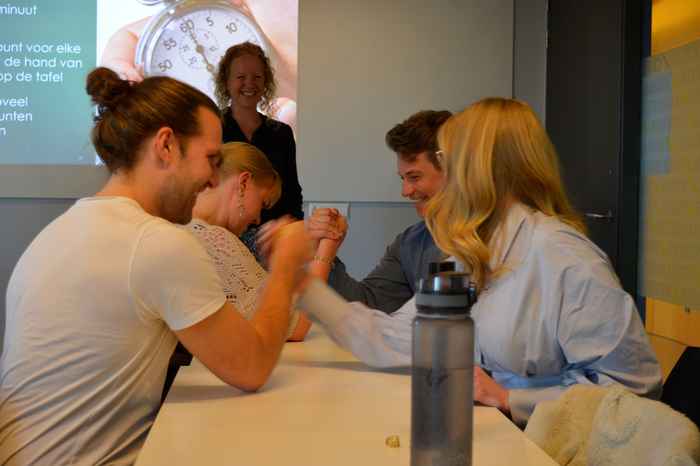Motivated students and room for personal growth: Inner Development Goals integrated for the first time into the elective course ‘Lost in Translation? Dialogue in Times of Polarisation’
23 April 2025
The power of dialogue
Judith explains: “This course goes back to the basics, creating space for connection to become possible again. Students explore various forms of dialogue, uncover what lies beneath opposing viewpoints, and practice how to truly listen and understand—especially in the role of facilitator.”
After years of experience in conflict zones, Judith now uses her knowledge to teach students how to deal with polarisation in the Netherlands. The course is open to students from all disciplines who want to learn how to navigate difficult conversations. It teaches how to counter polarisation in a peaceful way. The students themselves also feel the urgency of this. For example, student Nadine says that her interest in the course partly stems from concerns about polarisation in the Netherlands, but that the approach offers hope.
Many people engage in discussion without really knowing how to engage in an in-depth conversation. With different points of view, the discussion can polarise. “But by using the dialogue method, you can broaden your perspective and that of the person you’re speaking with,” Judith says. She gives an example: two individuals may appear to be political opposites. “But when you go deeper and ask the right questions, you often find they’re grappling with the same underlying concerns. Their positions might differ, but the core issues are often shared. And that’s where real connection can happen—even if their solutions remain different.”
Developing Courage, Empathy and Trust
This course is a first of its kind because it is built around the Inner Development Goals. The three core goals in this course are courage, empathy, and trust. Judith teaches students how to shape a dialogue process: from creating safety and structure to making their own choices.
“I want to empower the students to feel confident and find the courage to initiate conversations,” Judith says. “Empathy is key to understanding others without judgment—even when their views are very different from yours. And trust is fundamental to dialogue. It develops gradually, even between people who initially distrust each other or wouldn’t normally engage. That distance can suddenly shift into connection.”
Judith sees the participants in the course grow in both confidence and skills. Because the students are discussing difficult topics, they’ve also become a close-knit group. “They really dare to engage in conversations about tough subjects. They experiment freely and are not afraid to make mistakes.”
When difficult topics arise, a lot of safety is needed. Distance can suddenly shift into connection.Judith van den Boogert
From theory to practice in eight weeks
Safety is essential when discussing sensitive topics. Students experience this firsthand from the very first session in a dialogue exercise. Over the following weeks, they explore the structure and value of dialogue, conduct conflict analyses, and reflect on cultural inclusion and exclusion through activities such as a museum visit and an identity exercise.
In the final part of the course, students take on the role of dialogue facilitator, receiving peer feedback as they design and guide sessions. They explore different settings, including a Keti Koti dialogue table, political dialogues and trust-building in long-term processes. Theory and practice are closely intertwined, with plenty of space for reflection and exchange—something students greatly appreciate. Nadine, a student of Interdisciplinary Social Sciences, shares: “What I like is the mix of learning styles. It’s theoretical, but also about building real skills—something that’s quite rare at university.”
Recognising emotions and reading body language
A crucial part of dialogue is understanding how the body reacts to stress. Drawing on polyvagal theory, Judith teaches students to recognise signs of the fight, flight, or freeze response—both in themselves and in others.
Emotions are allowed—. If someone gets very angry or wants to leave, it’s not helpful to confront them right away. The body is activated—heart rate increases, adrenaline kicks in—and logical thinking partially shuts down. You can help calm the body through a grounding exercise, movement or a short break. Step by step, you bring people back to calm and clarity, and that creates space for dialogue again.”
Personal development
In addition to the group sessions, students work together in small groups to design a dialogue process around a topic of their choice, applying their insights right away. At the end of the course, they submit a paper connecting theory to their findings and reflecting on their personal development.
Personal growth is at the heart of the course. Judith puts it plainly: “What do you bring to the table as a facilitator in a difficult conversation?”
Toward the end of the course, students become visibly more confident in navigating complex discussions. Nadine says the course opened her eyes to the potential of dialogue, and it helps to cope with feelings of powerlessness. Her classmate Queen adds: “I meet all kinds of people in daily life, and thanks to this course, I can now talk about that more effectively.”


More Information
The IIS elective course ‘Verkeerd Verbonden? Dialoog in tijden van polarisatie’ is part of the Empowered Minds project, which aims to embed affective learning into the educational programmes at the UvA.
Judith developed the tool “The Volcano of Change” in the Transition Makers Toolbox. This tool encourages a dialogue about personal and collective thoughts, emotions and interpretations.